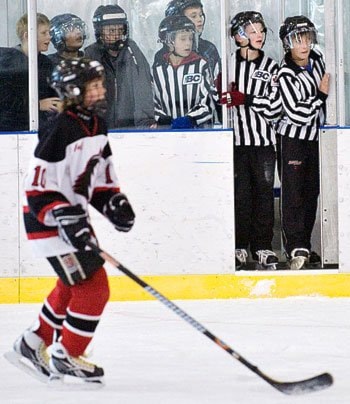Not only is it often a thankless job, sometimes it can be downright nasty.
Nonetheless, 25 Whitehorse youth hockey players attended a one-day course on Saturday to don the black-and-white and become referees.
“It’s an annual event where we have to certify and re-certify referees every year,” said John Berg, referee-in-chief of Yukon Amateur Hockey. “Level one, two or three - you have to go through the mandatory one-day clinic.”
Saturday’s course, held at the Canada Games Centre, was for those under 16 and Berg expects about a dozen to attend Tuesday’s course for older referees.
In minor hockey, younger refs can only officiate games in age groups below their own, so a bantam-level player can only ref in peewee and lower.
“We do it that way so they get respect and have confidence,” said Berg. “It just makes it easier, especially outside the rink, too.
“If you don’t have the confidence, you don’t get the respect on the ice. If you don’t know the rule, you miss it and you have people complaining.
“At this level they don’t get too much abuse because everyone knows they’re new.
“When you get up to bantam, midget stuff, yeah, (you need) thick skin.”
The large majority of those hoping to wear the vertical black-and-white stripes are hockey players, but often they come into the classroom segment of the course unaware of the details involved with many of the calls they themselves have been called on, said Berg.
“They might know the penalties, but (not) what constitutes a penalty, what constitutes an off-side, the defining points of how we managed those calls,” said Berg. “They don’t understand how to make a call. If we go through all that, like deflections on an off-side, it’s an automatic off-side, their eyes are wide open -‘Wow, we didn’t know that.’”
The best teaching method is baptism by fire, said Berg. You have to get would-be refs out on the ice and “throw them into the mix,” but the course also includes a written exam. If it sounds like an easy process, consider that a third of those who come out never end up blowing a whistle on the ice, since even positioning and knowing all the rules can be overwhelming.
“Where to stand; there’s lots of places to stand,” said Andrew Jensen, 11, an aspiring ref, when asked what is the most challenging part of reffing a game. “Also, when to make the call because sometimes you don’t see it when something happens.”
“Probably the calls,” said Tyson Hope, 12, another ref-to-be. “I know three for sure, but I’m not really sure about the other ones.”
Each year Berg travels south to Kelowna, BC, to attend an amateur hockey clinic, get recertified and discuss and learn about changes with the constantly evolving sport.
The Kelowna trip gives him the authority to certify referees in the Yukon.
“All us instructors go over new rules, go over procedures for teaching and our own development,” said Berg. “Over the years there’s been a lot more emphasis on no checking to the head, and a lot less interference, cross-checking and hooking.
“They want to speed up the game, like the international game, so the tolerance for those penalties is a lot less than it used to be.”
Although the territory could have close to 40 new referees policing the ice by the end of the week, Berg admits there’s still one area that’s lacking.
“It’s tough to get more girls out,” said Berg. “There’s lots of opportunity for girls too, especially officiating, because there’s more and more women’s hockey.”
Contact Tom Patrick at
tomp@yukon-news.com
